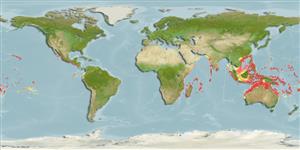Classification / Names
Common names from other countries
Main reference
Size / Weight / Age
Max length : 70.0 cm TL male/unsexed; (Ref. 57749); 200.0 cm TL (female); common length : 26.3 cm TL male/unsexed; (Ref. 35840); max. published weight: 20.5 kg (Ref. 13337); max. published weight: 20.5 kg; max. reported age: 40 years (Ref. 48660)
Environment
Marine; freshwater; brackish; demersal; catadromous (Ref. 51243); depth range 1 - 400 m (Ref. 6898)
Climate / Range
Tropical, preferred ?; 24°N - 33°S
Distribution
Short description
Vertebrae: 100 - 110. Adults have a brownish to black marbling on their back on a greyish yellow background. This coloration can fade away. White belly. Younger specimens are greyish to orange and the marbling is less visible (Ref. 48622). Body color brown speckles scattered on back, sides and fins; yellow between speckles and edge of pectoral fin; belly white or pale blue (Ref. 45563). Head rounded; snout depressed; lower jaw protruded; gill openings small; scales matted-like under skin; pectoral fin rounded; pelvic fin absent (Ref. 45563). Distinguished from all other species by the mottled color and the long dorsal fin, which begins closer to the gill opening than to the anus (Ref. 9828).
IUCN Red List Status (Ref. 115185)
Threat to humans
Harmless
Human uses
Fisheries: commercial; aquaculture: commercial; gamefish: yes
More information
ReferencesAquacultureAquaculture profileStrainsGeneticsAllele frequenciesHeritabilityDiseasesProcessingMass conversion
Tools
Special reports
Download XML
Internet sources
Estimates of some properties based on models
Phylogenetic diversity index
PD50 = 0.5000 many relatives (e.g. carps) 0.5 - 2.0 few relatives (e.g. lungfishes)
Trophic Level
3.8 ±0.67 se; Based on food items.
Resilience
Very Low, minimum population doubling time more than 14 years (tmax=40)
Vulnerability
Very high vulnerability (75 of 100)
Price category
